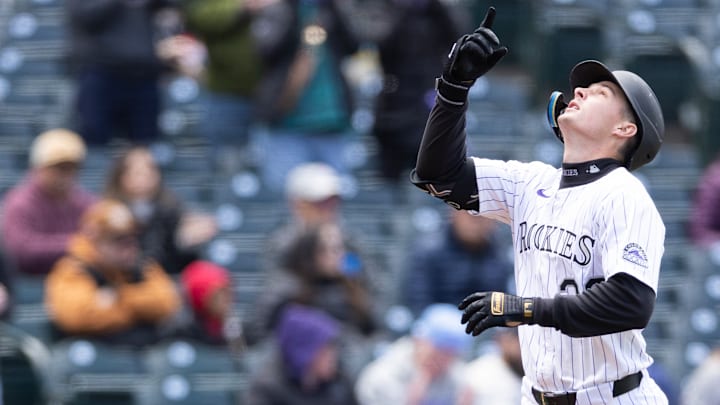After a brutal spring training that foreshadowed more of the same, the Angels somewhat surprisingly issued Mickey Moniak his walking papers during the final round of roster cuts heading into the regular season.
Moniak, a former first overall pick, was left to scramble to find a team, with most around the league already having their rosters set, and ultimately agreed to a one-year deal with the lowly Colorado Rockies.
After being acquired from the Philadelphia Phillies in the Noah Syndergaard trade, the once-promising outfielder struggled to live up to his potential. His .242/.279/.430 line during his time in Anaheim was emblematic of the power potential he possessed, and ultimately squandered, due to a severe lack of anything resembling plate discipline.
Moniak's power from the left side is undeniable, but his penchant for chasing first pitches and whiffing at junk rendered that tool useless and left him as a frustratingly below-average bat who was just competent as a defender in center field.
However, now in his new digs, Moniak is raking. Through 17 games, he's posted a .256/.347/.605 line in the thin Colorado air, and has seen his performance surprisingly buoyed by a 10.2% walk rate and an 18.4% strikeout rate. For reference, his career walk rate is a putrid 4.8%, and his career strikeout rate is a sky-high 31.6%.
Mickey Moniak is playing like an All-Star for the Rockies, but will the Angels regret moving on?
Even with half his home games coming in the Mile High City, Moniak won't continue to produce a .349 ISO that currently resides in Aaron Judge territory. Still, power has never been the issue for the talented-yet-flawed outfielder, who has instead been held back by an inability to make consistent contact.
The soon-to-be 27-year-old has seen an uptick in several key metrics that have fueled his early-season success. His hard-hit rate has massively spiked, going from 34.4% last season to 47.5% so far this year. His barrel percentage has risen as well, up over 3%, going from 9.3% in 2024 to 12.5% this year.
The quality of Moniak's contact has produced an expected batting average of .288 and an expected slugging of .534, indicating that the results, at least when bat meets ball, seem to be for real.
With that said, two glaring issues still persist that threaten to derail his season and prove that the early success was nothing more than a mirage. As we know, power has never been the problem for Moniak. Even in his worst years, when he got a pitch to hit in the zone, he most likely drove it.
The problems with Moniak's bat have been that far too often, he chases pitches out of the zone, resulting in either weak contact or a swing-and-miss. That has always been the underlying reason that he's struggled to draw walks and struck out at an unacceptably high frequency.
So far this year, his chase rate of 40.2% is almost identical to last season's 39.7% mark, and ranks in just the fourth percentile. Unsurprisingly, his whiff rate is also in the absolute cellar at 37.1% (fifth percentile), which is a decent amount worse than his already subpar 30.6% rate from last season.
In short, don't start cursing the Angels for letting Moniak go. He's doing exactly what he's always done, showing flashes of unlocking his incredible tools while still falling prey to the underlying issues that have kept him from reaching his full potential.
Angels fans have seen Moniak look like a star in short bursts, only for the bottom to fall out quickly. Now it's the Colorado Rockies' turn to get a taste of the Mickey Moniak medicine as he will almost assuredly regress to the mean as the season marches on.
